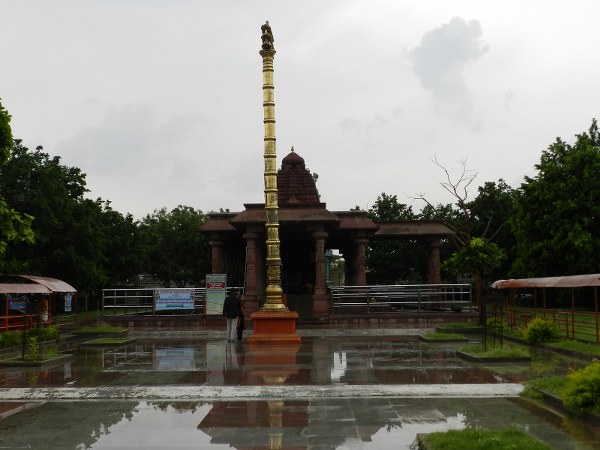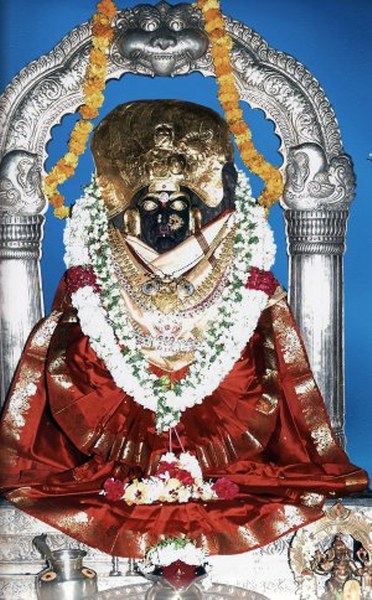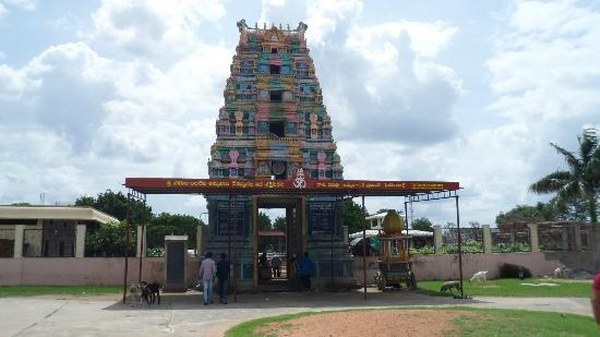 Jogulamba (also known as Yogulamba/Yogamba) is one of the eighteen Shakti peethas. Oordhva danta pankti (Upper jaw with tooth) of devi fell here. She is the Shakti of Bala brahmeswara swamy. Jogulamba mahadevi, Roudra veekshana loochana, Alampuri sthita mata, Sarvartha phala siddhida.
Jogulamba (also known as Yogulamba/Yogamba) is one of the eighteen Shakti peethas. Oordhva danta pankti (Upper jaw with tooth) of devi fell here. She is the Shakti of Bala brahmeswara swamy. Jogulamba mahadevi, Roudra veekshana loochana, Alampuri sthita mata, Sarvartha phala siddhida.
Alampur is a temple-town situated in Mahbubnagar district,in the state of Telangana, It is located at about 90 km from Mahabubnagar, 27 km From Kurnool and 200 km from Hyderabad. Alampur is the meeting point of the sacred rivers Tungabhadra and Krishna and is referred to as Dakshina Kashi(also known as Navabrahmeshwara Theertha) and the Western Gateway of Srisailam, the famous Shaivite (Shaivism) pilgrim centre. The principal deities at Alampur are Brahmeshwara and Jogulamba. It is surrounded by the Nallamala hills. Alampur is situated on the left bank of the Tungabhadra river.
Siginificance of Jogulamba Temple
Jogulamba can be understood as "Gruha Chandi" (protector of our homes). As we noticed, the idol shows that the goddess has a lizard, scorpion, bat and human skull in her hair. These are the indications of evil and signs of deterioration of a house. Lizard is the primary indication that a house starting to lose its life. Gradually, the number of lizards shall increase which result in the welcoming of scorpions which is even worse. The next level would be the entrance of bats which may result in death of humans living in that house. People believe that Jogulamba protects them and their shelters from all kinds of evils. She is also worshipped to be freed from Vastu Doshas (faults in constructions). The temple attracts a large number of pilgrims from various parts for the country and major festivals like Dussera, Maha Shivaratri are celebrated with pomp.
Alampur is the meeting point of the sacred rivers Tungabhadra and Krishna and is referred to as Dakshina Kashi(also known as Navabrahmeshwara Theertha) and the Western Gateway of Srisailam, the famous Shaivite (Shaivism) pilgrim centre. The principal deities at Alampur are Brahmeshwara and Jogulamba. It is surrounded by the Nallamalai hills. Alampur is situated on the left bank of the Tungabhadra river.
History
Alampur was under the rule of Shatavahana Ishvakus of Nagarjunakonda, Badami Chalukyas, Rashtrakutas, Kalyani Chalukyas, Kakatiyas, Vijayanagara Empire and Qutb Shahis of Golconda. Alampur was previously Known  as Halampuram, Hamalapuram And Alampuram. Name of this place as Hatampura, mentioned in the inscription dated AD 1101 belongs to Western Chalukya Tribhuvanamalla Vikramaditya VI. The Alampur Navabhrama Temples are historically important and reflect remarkable architectural skills.
as Halampuram, Hamalapuram And Alampuram. Name of this place as Hatampura, mentioned in the inscription dated AD 1101 belongs to Western Chalukya Tribhuvanamalla Vikramaditya VI. The Alampur Navabhrama Temples are historically important and reflect remarkable architectural skills.
According to historical sources, the temple was razed to the ground during Muslim invasion in 1390 AD. The local people put up a fierce resistance and killed the invaders and moved the main idol to the nearby Balabrahmeswara temple. Since then, the idol had been worshipped in the secluded place in the temple. The Chalukyas of Badami, mainly by the initiative of Pulakesin-II put up a number of temples in and around Alampur in the 7th and 8th centuries. At Alampur alone, Chalukyas built nine temples devoted to Navabrahmeswara and Jogulamba. Of them, eight magnificent temples of Navabrahmeswara survived but the temple of Tarakabrahma could not be traced. The Jogulamba temple was reconstructed at the same place where it stood. The temple was rebuilt in the same way it was described in the `Rasaratnakaram’ of Nityanatha Sidha of 12th century AD. Sankaracharya was believed to have installed `Sri Chakra’ at Jogulamba temple, which is not available now.
After those invasions the temple was neglected for over centuries. Later in the mid 1970s, the Archeological Survey of India (ASI) has taken over the temple and notified as a protected monument. Several pious people thought of re-constructing the temple but could not make it because of the restrictions made by the ASI. Later, Ajay Kallam, the then Commissioner of Endowments Department took initiative and showed special interest in the reconstruction of the temple. He worked relentlessly in raising the funds. Also, a great writer, Sanskrit scholar, researcher, reformist and epigraphist - Gadiyaram Ramakrishna Sarma took active part in the reconstruction of the temple and devoted his later life for the revival of the temple.
After many appeals from the devotees and Hindu scholars, the Archeological Survey of India (ASI) finally gave the clearance in 2002 and the temple was reconstructed at a cost of Rs.2 Crore. The new temple was built at the same place of the old temple and a set of new idols were consecrated on 13th February 2005. It took nearly 615 years to see the temple standing again at the same place. Idols of the presiding deity - Jogulamba, Dwarapalikas and Vahanamurthy (lion) were installed in the temple.
About Idol
The idol of deity Jogulamba is seen sitting with many scorpions, lizards, human skulls and bats. The idols of Veerabhadra, Vighneshwara and Saptmatrikas are also present besides the idol of Jogulamba. On the other hand, the original idols of Chandi and Mundi have been left by the army of Bala Brahmeshwara Swamy Temple. The Jogulamba Temple is considered the primary Shaktipeeth, where the upper teeth of Sati fell. The Alampur Navabrahma Temple is also located at Alampur district in Andhra Pradesh. There are nine Brahma temples in Alampur. All these temples have been dedicated to Shiva. These temples were constructed during the 7th century and were built by Badami Chalukya rulers, who were great patrons of architecture and art. They successfully depict the architectural heritage of the country. The Nav Brahma temples represent the Western and Northern styles of architecture rather than the Dravidian architectural style. About temple
About temple
Jogulamba temple is located in the South-East corner of the village beside Tungabhadra river. Old temple of Jogulamba was destroyed by Bahamani sultans in the 14th century. The idols of Jogulamba and her two shaktis Chandi, Mundi were protected from them and placed in Bala brahmeswara swammy temple until 2005. The new temple constructed in the same place and the goddess was relocated. As per the local people Jogulamba is an Ugra rupa (highly energetic and hard to worship) and the water pool nearby it makes the atmosphere cool.
Reconstruction of the Temple
The construction of the temple started during 2002, under the supervision of an advisory committee which included the Kanchi Kamakoti Peethadhipati, Sringeri Peethadhipati, Gadiyaram Ramakrishna Sarma, the then district collector, Sri Satya Sai Trust and Nagarjuna Group. One S.P. Perumalachary, the Sthapati or the architect of temples of Endowments Department of Tamilnadu was the man behind the reconstruction of the old temple. The new temple resembled more like the original one built in Chalukyan style and design. S.P. Perumalachary, who is said to be the architect with extra-ordinary engineering and visionary skills, studied extensively the architectural style of Chalukyan Era and their skills. He and his team of 100 sculptors (from Tamilnadu, Karnataka and Andhra Pradesh) left no leaf unturned to make the new temple identical to the original one, be it the selection of stones, the carvings of idols, pillars etc.
He has made great contributions to Andhra Pradesh that augmented the culture and heritage of the state. Some of his outstanding works include the renovation of Lord Sri Rama temple of Bhadrachalam and the carving of Buddha statue in the Hussain Sagar (lake) of Hyderabad. Reportedly, one of his future ambitions is to make a singular monolith (single piece of rock) statue of Lord Krishna chiseled from the granite reserve at Raigiri hill (Nalgonda district), where the boulder for Hussain Sagar Buddha statue was procured.
According to a legend, Maharshi Jamadagni has an ashram in Alampur & lived with his wife Renuka and four sons. They were making their livelihood and worshipping Bala Brahmeswara and Jogulamba Devi. Renuka Mata, with her power, regularly used to make a pot with sand and bring water from the Tungabhadra River. One day, she noticed a king of Gandharvas bathing in the river with his wives. By seeing that, she formed a prejudice that happiness comes from materialistic wealth but not by worship. She lost her power for her sinful thoughts and could not make the pot. So, she went home without water. Jamadagni asked her the reason; she told about the incident and admitted her sinful thoughts. Then, Jamadagni got angry on her and ordered his sons to kill her. Three of them refused to do so; but the fourth son, Parasurama obeyed the order of his father and killed his mother by cutting her head off with his axe. Jamadagni was pleased and offered him a boon. Parasurama asked him to give back life to his mother. Then Jamadagni revived her life. Legends say that the head of Renuka Mata became Ekaveera Devi, a symbol of Maya rupa; (materialistic thoughts) and the headless body became Bhudevi, a symbol of Matru rupa (mother). Many people say that Ekaveera Devi manifested herself as Goddess Yellamma in Undavelli village near Alampur. Where as, the shrine of Bhudevi is present in the premises of Bala Brahmeswara temple.
About Goddess
Idol of Jogulamba is in sitting position has a huge amount of hair with lizard, scorpion, bat and a human scull in it. Idols of Saptamatrikas, Vighneswara and Veenapani veerabhadra are also present. Original Chandi Mundi idols were left in Bala brahmeswara swammy temple and new idols are made and placed in Jogulamba temple.
Placed in Jogulamba Temple
Alampur is the home of very ancient Navabhramma temples dating back to the 7th century CE. The Nava Bhramma temples were built by the Badami Chalukyas, who ruled for about 200 years from the middle of the sixth century onwards. The Badami Chalukyas built several temples in Karnataka, and the Alampur temples in Andhra Pradesh.The Alampur site preserves archeological remains in the form of temples exhibiting a hybrid style of architecture – dating back to the 6th-7th centuries CE. Some of the images from this site are also housed in a museum nearby.
The Nava Bhramma temples are Taraka Bhramma, Swarga Bhramma, Padma Bhramma, Bala Bhramma, Garuda Bhramma, Kumara Bhramma, Arka Bhramma, Vira Bhramma and the Vishwa Bhramma. These temples are all enclosed in a courtyard on the left bank of the river Tungabhadra.
The Bala Bhramma temple is the principal shrine of worship. It dates back to the year 702 CE – per the inscriptions seen here. Shivaratri is celebrated in great splendour here.
The Taraka Bhramma temple is partly in ruins, and it has no image in the sanctum. It bears telugu inscriptions from the 6th-7th century CE. The Swarga Bhramma temple with an imposing tower is considered to be among the finest in Alampur, and is an excellent specimen of Chalukyan architecture and sculpture. It contains several sculptures in bas-relief, and it dates back to the end of the 8th century.
The Padma Bhramma temple partly in ruins, contains a Shivalingam of clear stone with mirror like finish. The Viswa Bhramma temple is among the most artistic of the Nava Bhramma temples. The sculptural work here depicts scenes from the epics.
Also in the enclosed courtyard is located the Suryanarayana temple, dating back to the 9th century. This temple has bas reliefs representing the incarnations of Vishnu. There is also a Narasimha temple with inscriptions from the period of Krishna Deva Raya of the Vijayanagar Empire.
Festivals
Dasara, Shivaratri and Bramhotsavams are celebrated in these temples.